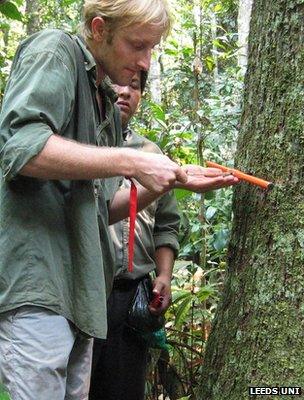Tree rings reveal Amazon's rainfall history
- Published

Samples from eight cedar trees in Bolivia have helped shed light on the seasonal rainfall in the Amazon basin over the past century, say researchers.
A study led by UK-based scientists said the data from the trees provided a key tool to assess the natural variation in the region's climate system.
It suggested that tree-rings from lowland tropical cedar provided a natural archive of rainfall data.
"Climate models vary widely in their predictions for the Amazon, and we still do not know whether the Amazon will become wetter or dryer in a warmer world," said co-author Manuel Gloor from the University of Leeds.
"We discovered a very powerful tool to look back into the past, which allowed us to better understand the magnitude of natural variability of the system."
The researchers explained that the region's vast size and position on the equator, the response of the forested area's hydrological cycle "may significantly affect the magnitude and speed of climate change for the entire globe".
Dr Gloor added: "In a similar way that annual layers in polar ice sheets have been used to study past temperatures, we are now able to use tree rings of these species as a natural archive for precipitation over the Amazon basin."
Wooden signal
The team identified the signal in measurements of two different forms (or isotopes) of oxygen within the wood of Cedrela odorata.
Within tropical and sub-tropical evergreen rainforests, trees' growth rings are less pronounced than in other woodlands - such as temperate regions - as there is no discernable dry season and temperature variations are minimal.
But lead author Roel Brienen, from the University's School of Geography, explained: "We already knew that some tropical tree species form annual rings and we also anticipated that the isotopic signature in these rings might record changes in the climate.
"What surprised us, however, is that just eight trees from one single site actually told us how much it rained not just at that site but over the entire Amazon catchment," Dr Brienen added.
"The isotopic values recorded in the tree rings were very closely related to annual variation in the river levels of the Amazon, and thus the amount of rainfall that flowed into the oceans."
The researchers added that about 17% of the annual discharge from rivers into the world's oceans comes from the Amazon.
Also, they said, the basin's hydrological cycle is closely tied to the carbon cycle of the rainforest, which is one of the planet's largest terrestrial biomass carbon pools.
The cedar species used in the study has shallow roots, therefore they are more dependent on water they are able to gather from rainfall that gathers in topsoil.
Dr Brienen observed: "The record is so sensitive, we can say what year we are looking at.
"For example, the extreme El Nino year of 1925-26, which caused very low river levels, clearly stands out in the record."
Until now, reliable meteorological data in the region was scarce and only stretched back over the past 50-60 years.
- Published26 August 2012
- Published20 December 2011
- Published18 February 2011